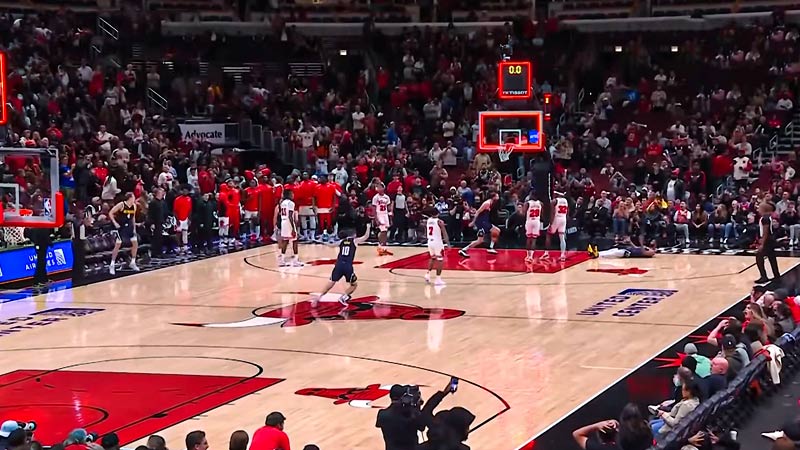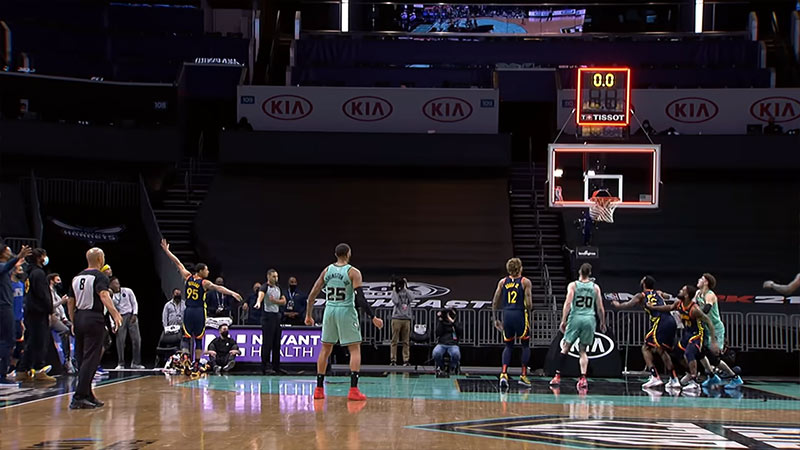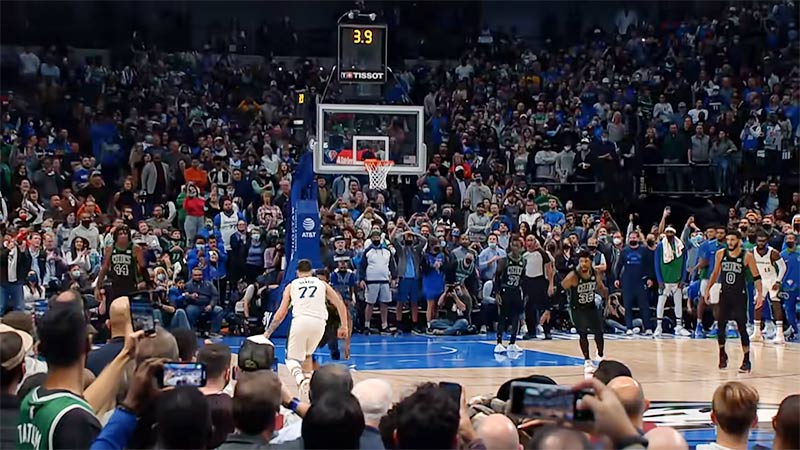The dimensions of an NBA basketball court are crucial to the game, providing a standardized playing area for professional basketball.
The measurements, including the length and width, help players, coaches, and fans appreciate the strategic aspects of the game.
In this article, we will delve into the complete dimensions of an NBA basketball court, explore how to calculate the court in yards, and discuss how to measure the basketball court lines in yards. So, stay focused.
How Many Yards Is an NBA Basketball Court?
An NBA basketball court measures 94 feet in length and 50 feet in width. To determine the length and width in yards, we can convert the measurements. Since one yard is equal to three feet, the length of the court, 94 feet, is approximately 31.33 yards.
Similarly, the width of the court, 50 feet, is approximately 16.67 yards. These measurements provide a clear understanding of the size and dimensions of an NBA basketball court when expressed in yards.
These standardized measurements ensure consistency and fairness in professional basketball games.
Complete Dimension of the NBA Basketball Court

An NBA basketball court follows specific dimensions to ensure consistency and fairness. The court measures 94 feet in length and 50 feet in width, providing ample space for players to showcase their skills and athleticism.
These dimensions are standard across all NBA courts to maintain uniformity in gameplay and facilitate fair competition.
The boundaries of the basketball court are marked by boundary lines that outline the playing area. These lines serve as reference points for determining in-bounds and out-of-bounds plays.
The outermost lines establish the out-of-bounds limits, ensuring that players stay within the designated area during gameplay.
One prominent marking on the NBA court is the three-point line. It is located 23 feet 9 inches away from the center of the basket in most areas of the court.
However, in the corners, the three-point line extends to a distance of 22 feet. The three-point line plays a significant role in the game, determining the value of shots taken from beyond that line.
Another notable marking on the court is the key, also known as the paint or restricted area. The key is a rectangular area that stretches from the baseline to the free-throw line. It is 16 feet wide and serves multiple purposes in the game.
Defensively, it helps determine proper positioning and defensive strategies, while offensively, it aids in creating spacing and opportunities for drives and post-up plays. The key also provides guidelines for defensive three-second violations, ensuring fair play.
The free-throw line is another essential feature of the NBA court. It is located 15 feet away from the backboard and is the designated spot from which players attempt free throws during games.
Free throws are awarded to players who have been fouled by their opponents, providing them with an opportunity to score uncontested points.
The dimensions and markings on the NBA basketball court are carefully designed to create a standardized playing surface for teams across the league.
These elements contribute to fair gameplay, strategic positioning, and the showcasing of players’ skills and abilities.
How to Calculate the Basketball Court in Yards?
To determine the length and width of an NBA basketball court in yards, we need to convert the measurements from feet to yards. One yard is equal to three feet, so we can calculate the length and width as follows:
Length (in yards) = 94 feet / 3 feet/yard = 31.33 yards
Width (in yards) = 50 feet / 3 feet/yard = 16.67 yards
Therefore, an NBA basketball court measures approximately 31.33 yards in length and 16.67 yards in width when converted from feet to yards.
These measurements provide a perspective on the size and scale of the court, showcasing the significant playing area available for NBA players to compete at the highest level.
How to Measure the Basketball Court Lines in Yards?

To accurately measure the various lines on an NBA basketball court in yards, it is important to understand the specific markings and their corresponding lengths.
Here are the measurements and conversions for some key lines on the court:
Three-Point Line
The three-point line is a significant boundary that determines whether a shot is worth two or three points. It forms an arc around the basket, with different lengths depending on the position on the court.
The distance is 22 feet in the corners and 23.75 feet at the top of the key. To measure these lines in yards, we can divide the lengths by 3, resulting in approximately 7.33 yards in the corners and 7.92 yards at the top of the key.
Key
The key, also known as the free-throw lane, is a rectangular area located in front of the basket. Its dimensions are 16 feet wide and 19 feet deep.
To measure the key lines in yards, we can divide the lengths by 3, giving us approximately 5.33 yards in width and 6.33 yards in depth.
Free-Throw Line
The free-throw line is a crucial element of the game, determining the distance from which players shoot free throws. It is located 15 feet from the backboard and extends horizontally across the court.
To measure the free-throw line in yards, we can divide the length by 3, resulting in approximately 5 yards.
These measurements highlight the dimensions of key lines on an NBA basketball court and their corresponding lengths in yards.
It is essential to have accurate measurements for court markings to ensure fair play and adherence to the rules of the game.
FAQs
Why are the dimensions of an NBA basketball court important?
The dimensions of an NBA basketball court are crucial for several reasons. Firstly, they ensure fairness and consistency in the game. All teams compete on the same-sized court, eliminating any advantage or disadvantage based on court size.
This promotes a level playing field and allows teams to showcase their skills and strategies without external factors affecting the game.
Moreover, the dimensions of the court contribute to strategic gameplay. Teams utilize the space on the court to create offensive plays, set screens, and execute defensive strategies.
Having standardized court dimensions enables players and coaches to develop and implement game plans effectively, knowing the exact measurements they have to work with.
Are the dimensions of an NBA basketball court the same for all levels of basketball?
No, the dimensions of a basketball court can vary across different levels of the sport. While the NBA follows specific court size regulations, other leagues, such as college or high school basketball, may have slightly different court dimensions.
These variations could be due to factors like available space, facility limitations, or historical conventions within a particular league or organization.
Can basketball courts be adjusted for international competitions?
Yes, basketball courts can be adjusted for international competitions to meet the requirements set by FIBA (International Basketball Federation), the governing body for international basketball.
FIBA has its regulations for court dimensions, including the size of the playing area, three-point line distance, key or restricted area size, and other specifications.
While the differences may be subtle, they ensure uniformity and consistency in international competitions.
Are the court dimensions the same for indoor and outdoor basketball courts?
No, the dimensions of outdoor basketball courts can vary and may not adhere to the standard NBA court dimensions. Outdoor courts often have different sizes and layouts depending on the available space and design preferences.
On the other hand, indoor basketball courts in professional arenas typically follow the official measurements set by the league to maintain consistency and standardization in the game.
How are the court lines maintained during a basketball game?
Court lines on a basketball court are typically maintained using paint or tape. The lines, including the boundary lines, midcourt line, three-point line, free-throw line, and others, are carefully marked and regularly inspected.
During breaks or between games, the lines may be refreshed, retouched, or repainted to ensure clear visibility and to comply with regulations and standards.
This maintenance ensures that players, officials, and spectators have a clear understanding of the court’s boundaries and markings throughout the game.
Bottom Line
The dimensions of an NBA basketball court are essential for players, coaches, and fans. Converting the measurements to yards allows for a different perspective and appreciation of the court’s size.
By following the standard measurements and properly maintaining the court lines, basketball can be played on a fair and consistent playing surface, ensuring the integrity of the game.
Hope this little effort enriched your knowledge of basketball a bit more. Thank you for being with us here.







